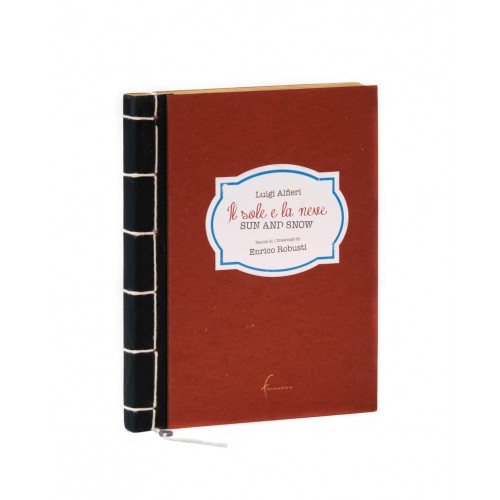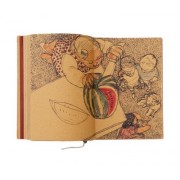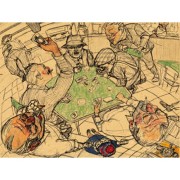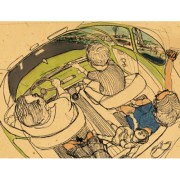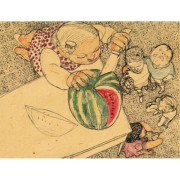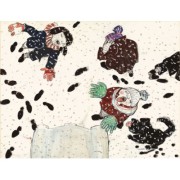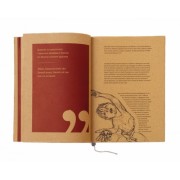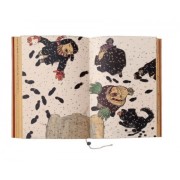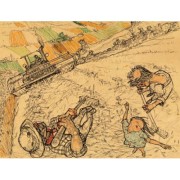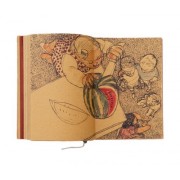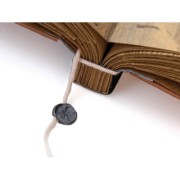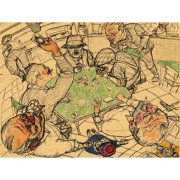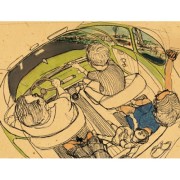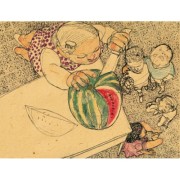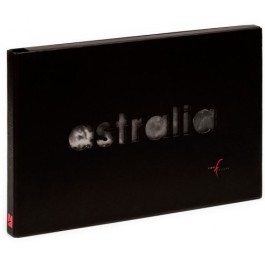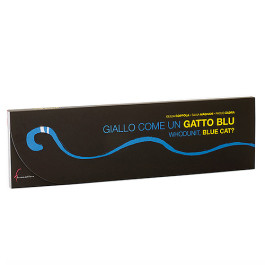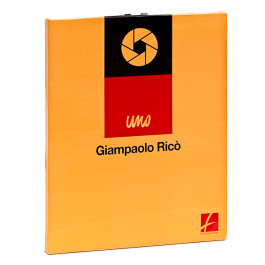Product Description
The book
Sun and snow challenges the eBook. An object-book, palpable and real, that challenges the virtual book, the civilization of the algorithm. A handcrafted book: to be held, perused, inhaled, rested on the nightstand. A treasure chest of sensations, beyond narration and drawings. A counter-revolution that starts with materials. The cover is made of cardboard, just like schoolroom attendance books or the registers used by breeders to report their «beasts’» daily production. Text and images are printed on straw paper, used by grocers in the sixties to wrap cheese and lunch meats. Strictly manual, the binding is made of twine, the same used for salami and ham hocks. Whispers, tactile sensations, colorful brilliance appear when turning the pages, leading to the heart of the story, deep in the 1960s Italian countryside.
Sun and snow comprises 142 mini stories or ‘confetti’, arranged in order of casual appearance: only after reading all of them can we finally discover the plot of a single tale. Set in the area of Parma during the 1960s, the story spans over a period of fourteen years – from the age of innocence to the realization of death – through the succession of months and seasons, observing the changes in nature, and remembering the pleasure of living immersed in the passage of time. Beginning and ending in June, we witness a boy becoming an adult, amidst the woods, fields, skies, rivers and changing colors and lights, all emanating new fragrances. Alongside the story’s protagonists, the innocent boy and countryside are an ample chorus of characters narrated in just a few lines; one of these characters, the father, through his death, slowly becomes the true hero.
The texts are accompanied by the drawings of a great artist, Enrico Robusti. The images are not present to illustrate the volume, but to reread the story with the same reality, the same human and natural situations, through a different viewpoint, another soul and sensibility. The images form a book within a book, the painter becoming the writer of a parallel tale: while the words in Alfieri’s texts often evoke colors, the drawings by Robusti show colors that often speak in words. The representation of life, happiness, nature, love and death can differ from one person to another – and in this case, from page to page, and sign to sign.
Fermoeditore has given life to the suggestions from the text and images using straw paper, which is traditionally linked to food products, and provides a strong emotional impact; a robust yet delicate material. This base serves to express the work’s airy characters, and the colors of the tableaus as conceived by the artist – never casual, obtained through numerous attempts. The images are displayed without undesired folds, printed on a bellows page layout. To share the story with non-Italian readers, a hidden translation appears underneath the original language, thanks to an innovative technique, with each text laid out as if it were the only one. The laminated cardboard cover and canvas back, in an evocatively rustic and colorful design, provide a prelude to the ideas contained within the book; the Japanese styled binding will appeal to those with a taste for a refined page layout. The result is a work of art, a pleasure to read and browse through.
The authors
Luigi Alfieri (Cella di Palmia, Parma, 1957) is a travel journalist. He has been president of Neos, an association that regroups journalists and photographers in the sector. His books include both fiction and non-fiction works (among which Il piccolo Socrate, published by Guanda), as well as books on food and current events. He has produced a feature length film on drug addiction, broadcast by Rai Uno. He is editor in chief of the Gazzetta di Parma, Italy’s most historic daily newspaper, and has collaborated for over a decade with La Stampa of Turin. He has organized photographic exhibits and conventions on travel, poetry and literature in general. In May 2011, he published his latest book: Dune, balene e microchip, sette anni in giro per il mondo [Dunes, whales and microchips, seven years traveling around the world].
Enrico Robusti is an artist based in Parma. Following classical studies and a law degree, he dedicated himself to painting, with a special interest in the 17th century works of Van Dick and Rubens. In 1991, he was presented by Federico Zeri in an exhibition of portraits at the Consigli Arte. From that moment onwards, Robusti made portrait painting his profession. Since 2004, he has undertaken a new expressive path, garnering a number of significant national and international awards, including a personal exhibit at the Albemarle Gallery in London in 2011, and participating in the 54th Venice Biennale.
Technical details
Size 24,5×32 cm
Cover: 2 mm thick cardboard leather, one-colour silk screen printing in white and two colours on straw paper, 100 g/sq. m. coupled; die-cut label f.to 15×11 cm printed in four-colours.
Inside: four sheets with two “closed” sides, printed in two colours in white, on straw paper 100 g/sq. m; twelve sheets with four “closed” sides, printed in five colours in white, on straw paper 100 g/sq. m.; seventeen sheets with four “window” sides, printed in two colours per part.
Handmade binding; book entirely produced in Italy.
Upon request it is possible to order the deluxe edition, only three hundred copies, signed and numbered, of this book were printed: a real art series.
Info: info@fermoeditore.it
 English
English  Italiano
Italiano 

